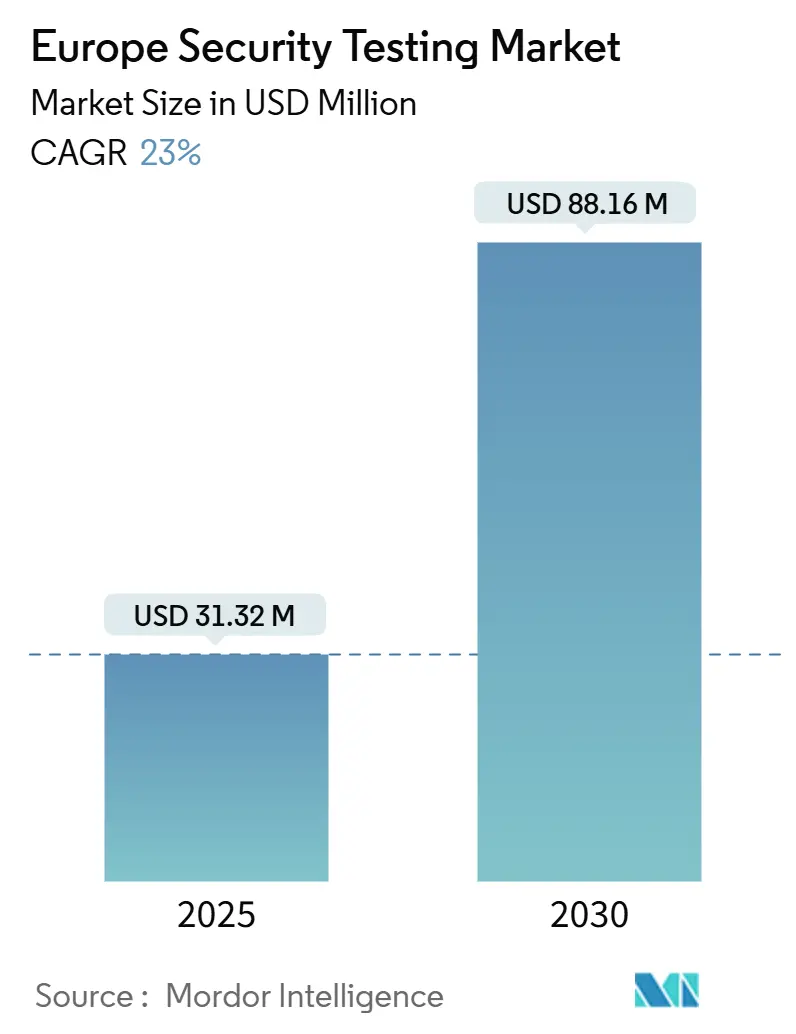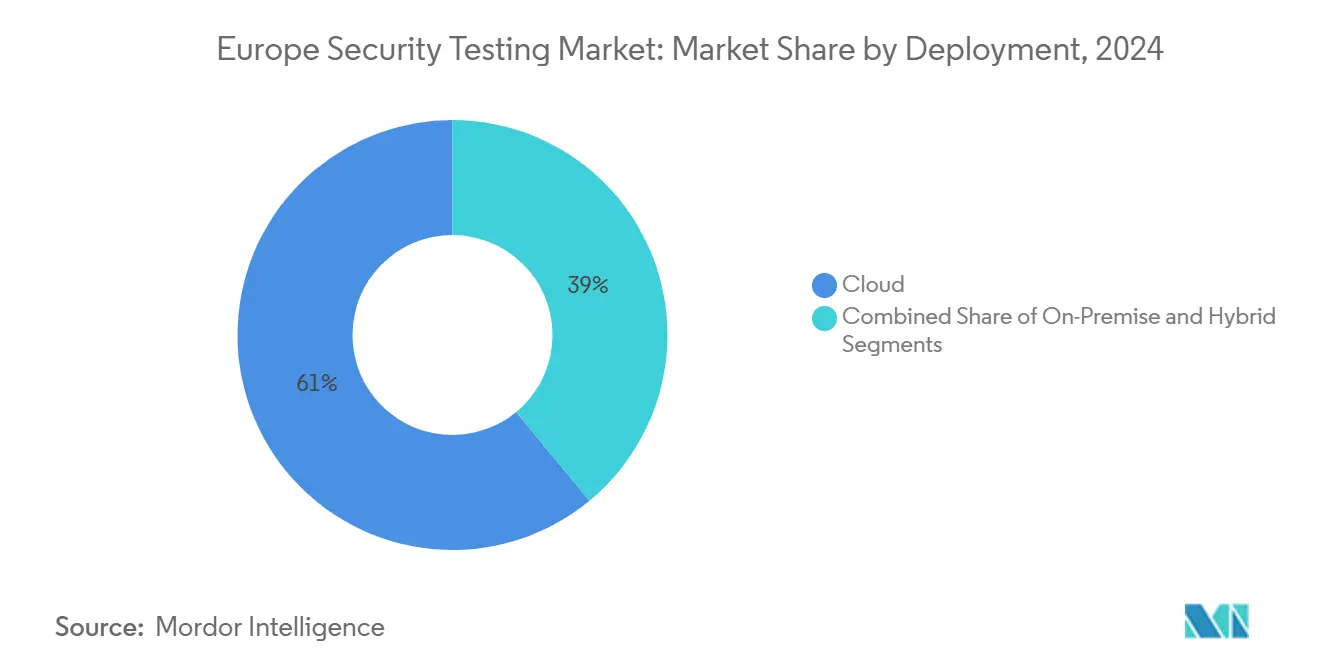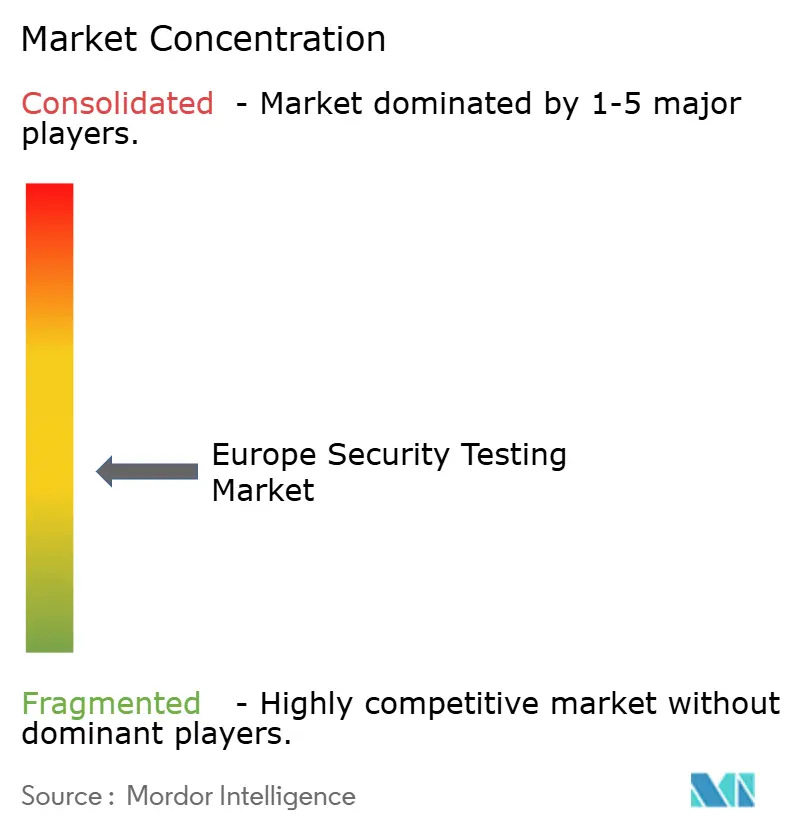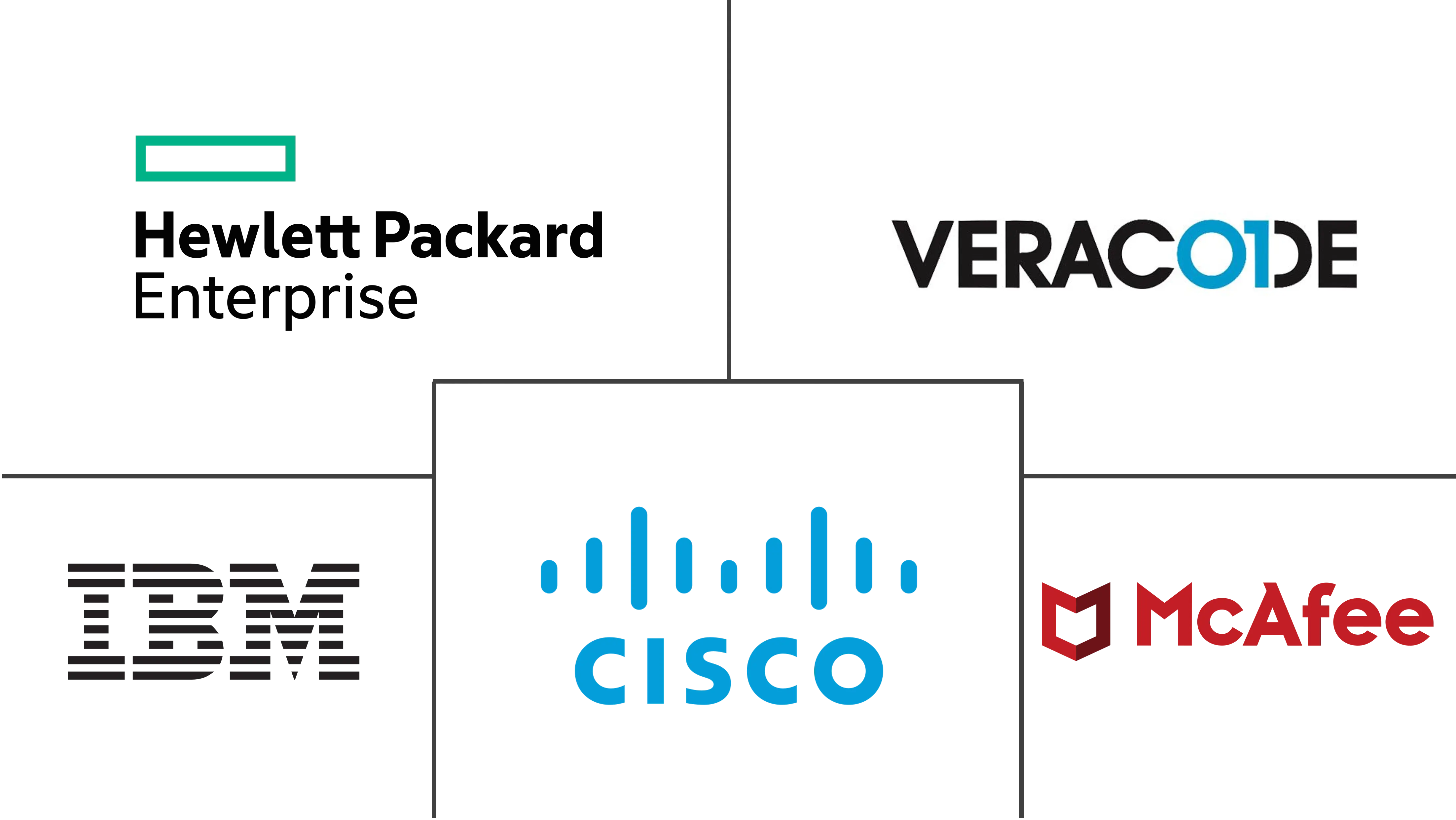
Europe Security Testing Market Analysis by Mordor Intelligence
The Europe Security Testing Market size is estimated at USD 31.32 billion in 2025 and is projected to reach USD 88.16 billion by 2030, growing at a robust CAGR of 23% during the forecast period. This nearly threefold expansion reflects the intensifying digital threat landscape across Europe, where organizations face increasingly sophisticated cyber threats amid accelerated digital transformation initiatives. The market's growth trajectory is significantly steeper than historical patterns, indicating a fundamental shift in security priorities across the continent.
The market is being reshaped by stringent regulatory forces, particularly the implementation of the Network and Information Security Directive 2 (NIS2) and Digital Operational Resilience Act (DORA), which mandate comprehensive security testing for critical sectors. Cloud deployment dominates with 61% market share in 2024, while application security testing represents the largest type of segment at 39%. The United Kingdom leads geographically with 23.11% market share, though France exhibits the fastest growth at 26.4% CAGR through 2030, driven by substantial government investments in cybersecurity infrastructure.
Competitive intensity in the market is escalating as established players like Accenture and IBM face pressure from specialized European security testing providers leveraging AI-driven automation to deliver more efficient testing solutions. The market is witnessing a notable shift toward Interactive Application Security Testing (IAST), growing at 27.8% CAGR, as organizations seek to reduce false positives and integrate security earlier in development cycles. This trend is particularly pronounced in the manufacturing sector, which is experiencing the fastest growth among end-users at 25.2% CAGR due to increasing industrial IoT adoption and the convergence of IT and OT security requirements.
The fragmented data sovereignty rules across EU member states are creating implementation challenges for cloud-based security testing solutions, though this is simultaneously driving innovation in hybrid deployment models that can satisfy both operational and compliance requirements. The market's evolution is further characterized by the emergence of specialized testing methodologies for quantum-resistant cryptography, particularly in financial services and government sectors, where early pilots are already underway to prepare for post-quantum security threats.
The Europe security testing market is valued at USD 31.32 billion in 2025 and is forecast to climb to USD 88.16 billion by 2030, reflecting a 23% CAGR that outpaces prior growth trajectories. Heightened cyber-attack frequency, tougher European regulations, and deeper cloud adoption collectively underpin this rapid expansion. Mandatory assessments under NIS2 and DORA, combined with a system-wide shift toward DevSecOps, are translating regulatory pressure into sustained commercial demand. Cloud-based offerings, fortified by sovereign-cloud controls, are widening access for mid-size enterprises, while AI-driven automation is helping providers counter an acute shortage of CREST-certified testers. Finally, emerging specialisms such as quantum-resistant cryptography testing hint at new revenue streams as Europe’s digital transformation advances.
Key Report Takeaways
- By deployment, cloud solutions held 61% of the Europe security testing market share in 2024; the segment is forecast to post a 26.01% CAGR through 2030.
- By type, application security testing commanded 39% revenue share of the Europe security testing market in 2024, while cloud-focused AST is projected to expand at a 31% CAGR to 2030.
- By testing tool, penetration-testing platforms led with 27% share of the Europe security testing market size in 2024; interactive application security testing is the fastest-growing tool category at 27.8% CAGR.
- By end-user industry, BFSI accounted for 22% of the Europe security testing market size in 2024, whereas manufacturing is advancing at a 25.2% CAGR on the back of IIoT uptake.
- By geography, the United Kingdom retained 23.11% of the Europe security testing market in 2024; France is the fastest-growing national market with a 26.4% CAGR to 2030.
Europe Security Testing Market Trends and Insights
Drivers Impact Analysis
| Driver | (~) % Impact on CAGR Forecast | Geographic Relevance | Impact Timeline |
|---|---|---|---|
| Post-2023 critical-infrastructure cyber-attacks | +5.5% | Germany, France, United Kingdom | Medium term (2-4 years) |
| Accelerated NIS2 & DORA compliance | +4.8% | EU-27 | Short term (≤ 2 years) |
| Shift-left DevSecOps adoption | +3.9% | United Kingdom, Germany, Nordics | Medium term (2-4 years) |
| Industrial IoT penetration in German Mittelstand | +4.2% | Germany, Central Europe | Medium term (2-4 years) |
| Public-sector tender mandates for pen-testing | +2.3% | EU-wide | Short term (≤ 2 years) |
| Source: Mordor Intelligence | |||
Heightened Post-2023 Critical-Infrastructure Cyber-Attacks
A succession of sophisticated attacks on European power grids and rail systems in 2024 pushed critical-infrastructure operators to overhaul testing blueprints. ENISA logged a 38% rise in incidents, with OT infiltration techniques bypassing legacy perimeter controls. Security budgets have been redirected toward services capable of mapping vulnerabilities across converged IT-OT environments, especially in distribution networks handling supervisory control and data acquisition traffic. Providers responding with combined red- and blue-team engagements are benefiting from contract sizes that now extend across multi-country footprints. Expansion of mandatory incident reporting regimes further cements demand, as real-time testing evidence becomes essential for regulatory filings. [1] European Union Agency for Cybersecurity, “2024 Report on the State of Cybersecurity in the Union,” enisa.europa.eu
Accelerated EU NIS2 & DORA Compliance Deadlines
NIS2 enforcement in October 2024 and DORA’s go-live in January 2025 compressed compliance windows and forced organizations to institutionalize recurring security assessments. DORA’s three-year threat-led penetration-testing cycle for banks has already triggered multiyear framework agreements with external testers, while NIS2’s supply-chain focus is driving downstream validation of third-party code repositories. Cross-border conglomerates are centralizing test orchestration to avoid audit duplication, spurring uptake of unified platforms that schedule, execute, and document evidence for multiple regulators.
Shift-Left DevSecOps Adoption in the Software Supply Chain
DevSecOps is advancing across European CI/CD pipelines as firms attempt to counter supply-chain exploits. Eighty-five percent of enterprises boosted pen-testing allocations in 2024, and runtime-integrated tools such as IAST are shrinking remediation expenditure by detecting defects during build stages. Continuous validation is becoming customary in BFSI and healthcare, where certification audits now request proof of in-pipeline controls. Early adopters report cost savings of up to 100-fold when addressing design-phase flaws compared with post-deployment fixes. [2]Velibor Cekic, “Embracing DevSecOps: A Path to Improved Software Security,” nortal.com
Industrial IoT Penetration in German Mittelst and Factories
German mid-sized manufacturers are digitizing shopfloors through IIoT sensors linked to enterprise resource planning applications. This convergence introduces cyber-physical risks that standard IT scanners cannot surface. Targeted EU funds of EUR 40 million (USD 44 million) are accelerating development of frameworks capable of validating both safety and cyber integrity of robotic cells and edge gateways. Demand is spilling into Central Europe as subcontractors harmonize test regimes with German parent companies. [3]European Commission, “Secure solutions for the Internet of Things,” digital-strategy.ec.europa.eu
Restraints Impact Analysis
| Restraint | (~) % Impact on CAGR Forecast | Geographic Relevance | Impact Timeline |
|---|---|---|---|
| Shortage of CREST-certified testers | -2.1% | United Kingdom, EU spillover | Medium term (2-4 years) |
| SME budget freezes after 2024 credit-tightening | -1.8% | EU-wide, Southern Europe focus | Short term (≤ 2 years) |
| Fragmented data-sovereignty rules | -1.5% | Germany, France | Medium term (2-4 years) |
| False-positive fatigue | -1.2% | Global | Long term (≥ 4 years) |
| Source: Mordor Intelligence | |||
Shortage of CREST-Certified Security Testers
Europe’s talent deficit remains acute, with the United Kingdom alone needing 7,000 additional professionals every year. The gap is especially sharp in cloud and OT disciplines, delaying project kick-offs for large transformation programs. Automation mitigates routine tasks yet cannot replace the contextual analysis clients expect from senior testers, thereby constraining the absolute delivery capacity of the Europe security testing market. [4]European Commission, “Secure solutions for the Internet of Things,” digital-strategy.ec.europa.eu
Budget Freeze Across EU-27 SMEs Amid 2024 Credit-Tightening
Higher funding costs have forced SMEs to defer discretionary spending, including penetration-testing renewals. While top-tier banks and energy utilities press ahead with schedules, mid-market retailers and logistics firms often opt for scope reductions or biennial testing cadences. This creates uneven security baselines in supply chains and complicates compliance audits for prime contractors that depend on SME partners.
Segment Analysis
By Deployment: Cloud Dominates Despite Sovereignty Concerns
Cloud-based models delivered 61% of the Europe security testing market in 2024 and are on track for a 26.01% CAGR through 2030. The Europe security testing market size for cloud deployment is projected to reach USD 54 billion by 2030, reflecting mounting demand for elastic test environments that replicate attacker geographies within minutes. United Kingdom enterprises typically launch weekly external attack simulations from cloud-native platforms, while German firms favour hybrid configurations that retain encryption keys on-premises. Providers now bundle sovereign-cloud controls such as in-region key management and dedicated SOC staffing to satisfy France’s strict data-locality statutes. On-premises installations remain relevant where classified information is processed, notably in defense ministries, yet even these agencies pilot secure “compute-out, data-in” patterns that keep test logs offsite while restricting raw data exfiltration. As European hyperscalers pledge multibillion-euro investments in regional zones, hybrid orchestration has emerged as a pragmatic bridge for organizations balancing operational agility with national-security mandates. The Europe security testing market therefore continues to pivot toward integrated deployment portfolios that shift workloads seamlessly between private racks and regulated clouds without disrupting audit trails.

Note: Segment shares of all individual segments available upon report purchase
By Type: Application Security Testing Accelerates with Cloud Focus
Application security testing (AST) generated 39% of the Europe security testing market revenue in 2024 and leads adoption curves as web, mobile, and serverless workloads multiply. Within AST, cloud-specific assessments post the steepest climb at 31% CAGR, propelled by DORA clauses obliging financial entities to review both legacy and containerized code. The Europe security testing market share for AST is bolstered by continuous integration tools that embed dynamic scans into commit pipelines, enabling risk triaging before production. Network security testing still anchors zero-trust rollouts, particularly for segmenting flat networks amassed through M&A activity. VPN assessments gained urgency following publicized remote-access exploits that bypassed multi-factor authentication. Firewall testing, formerly a ruleset hygiene exercise, now incorporates evasive-traffic emulation to gauge inspection depth against adversaries using domain fronting. As cloud, mobile, and API surfaces converge, enterprises increasingly commission unified engagements that cross-reference findings from multiple test types, maximizing coverage without inflating budgets.
By End-User Industry: BFSI Leads While Manufacturing Accelerates
Financial institutions absorbed 22% of 2024 revenues, compelled by unequivocal regulatory triggers. DORA’s operational-resilience stipulations require red-team exercises alongside business-continuity war-games, elevating security testing from a compliance checkbox to a board-level performance metric. Banks with cross-border operations are consolidating vendor panels to maintain audit consistency across subsidiaries. Manufacturing, however, is expanding faster than any other vertical at 25.2% CAGR as robotics, predictive maintenance, and edge analytics blur lines between corporate IT and plant-floor OT. European grants such as the Cyber Resilience Act intensify scrutiny of firmware updates and sensor authentication schemes. Healthcare follows closely, driven by European Medical Device Regulation clauses that obligate secure lifecycle management. Hospital procurement tenders increasingly embed language mandating third-party verification of both software and hardware modules, signalling durable demand.

By Testing Tool: Penetration Testing Tools Lead While IAST Grows Fastest
Penetration-testing suites secured 27% revenue in 2024, reflecting the broad applicability of offensive security across endpoints, networks, and embedded devices. Open-source toolchains such as Kali Linux remain prevalent, yet commercial platforms that streamline reporting and evidence collection are expanding inside regulated verticals. Hardware-assisted kits, including RFID cloners and side-channel analysers, are shipping in greater volumes as clients extend scopes to physical access controls. Interactive application security testing, however, is registering the sharpest upswing at 27.8% CAGR. Its in-runtime instrumentation reduces false positives, a pain point that previously discouraged frequent scans and contributed to alert fatigue. Integration with DevOps dashboards allows product owners to accept or reject findings in real time, tightening feedback loops. Consequently, the Europe security testing industry is migrating to blended toolchains that couple automated reconnaissance with targeted manual exploitation to confirm impact, a hybrid model that optimizes both coverage and tester hours.
Geography Analysis
The United Kingdom captured 23.11% of the Europe security testing market in 2024 on the strength of an advanced cybersecurity ecosystem and proactive legislative stance. Domestic revenue reached GBP 13.2 billion (USD 17.1 billion), with telecom regulation widening mandatory testing to network operators. A potent public-private partnership fosters rapid commercialization of academic research, giving rise to start-ups that automate scenario generation for penetration tests. London’s financial district serves as a testbed for combined DORA and PCI DSS engagements, positioning local vendors at the center of complex regional rollouts.
Germany ranks second, buoyed by its industrial base. Mittelstand manufacturers commission end-to-end assessments that span programmable logic controllers, cloud dashboards, and safety interlocks. Regional innovation hubs in Munich and Stuttgart host purpose-built OT test labs equipped to replicate entire production lines. The Europe security testing market size specific to German industrial clients is projected to grow at a double-digit clip as nationwide 5G campus networks come online, introducing new radio-access vectors that must be stress-tested against denial-of-service exploits.
France, while smaller today, is the fastest mover with a 26.4% CAGR forecast to 2030. Strategic sovereignty funds fuel domestic cloud infrastructure, and the newly launched Global AI Hub anchors a cluster of security-focused AI research projects. Government procurement policies that favor in-country data processing accelerate local provider revenues, while the country’s role in shaping EU cyber standards enhances first-mover advantage for firms that internalize fresh compliance codes early.
The Rest-of-Europe cohort displays heterogeneous maturity. Nordics routinely integrate security tests into agile sprints, reflecting a DevOps culture ingrained across public services. Eastern European software houses apply offensive-testing expertise honed in capture-the-flag competitions to international contracts, though pricing pressures remain. Southern Europe still trails, constrained by SME budget freezes; however, co-funded regional grants are beginning to narrow the gap. Overall, harmonization under NIS2 gradually levels expectations, yet enforcement velocity will likely continue to vary by member-state resourcing.
Competitive Landscape
The Europe security testing market features moderate fragmentation, with global consultancies, specialized boutiques, and SaaS-driven platforms all jostling for position. Network security testing is relatively consolidated because capital-intensive traffic-emulation infrastructure creates scale advantages for incumbents. Application testing, conversely, remains open to niche entrants that leverage open-source scanners patched with proprietary machine-learning modules.
Competitive intensity escalated in 2024 as household brands such as Accenture acquired six European cyber consultancies, adding red-team talent and regional data-sovereignty certifications. IBM doubled down on AI-assisted vulnerability prioritization, integrating its testing suite with watsonx to auto-rank exploitability. Meanwhile, homegrown providers in the Netherlands and Sweden differentiate on platform extensibility, allowing clients to graft custom threat libraries aligned with local critical-infrastructure scenarios.
Vertical specialization defines the next phase. Healthcare-focused firms invest in laboratories certified for IEC 62304 software safety, while OT specialists in Austria replicate entire supervisory-control networks to validate fail-safe logic under cyber stress. Quantum-resistant cryptography pilots in Luxembourg banks open yet another seam, with early movers designing specialized test harnesses for lattice-based key-exchange protocols. As AI regulation tightens, vendors that bundle ethical-AI security validations alongside conventional tests are carving out white-space.
Europe Security Testing Industry Leaders
-
International Business Machines Corporation
-
Cisco Systems, Inc.
-
Accenture plc
-
Hewlett Packard Enterprise Company
-
Synopsys, Inc.
- *Disclaimer: Major Players sorted in no particular order

Recent Industry Developments
- April 2025: Cisco unveiled a Global AI Hub in France to develop secure AI infrastructure aligned with the France 2030 agenda.
- March 2025: AWS confirmed a dedicated European Sovereign Cloud backed by EUR 7.8 billion (USD 8.6 billion), featuring local governance and a region-exclusive SOC.
- February 2025: The European Commission adopted the EN 18031 standards series, making cybersecurity testing mandatory for radio equipment from Aug 2025.
- January 2025: DORA entered into force, setting stringent ICT risk-management and security-testing obligations across 20 financial entity types.
Research Methodology Framework and Report Scope
Market Definitions and Key Coverage
Our study defines the Europe security testing market as all spending, expressed in US dollars, on software tools and professional or managed services whose primary purpose is to probe applications, networks, devices, and cloud workloads for security weaknesses and verify control effectiveness across European enterprises and public agencies.
Scope Exclusions: Vulnerability-management platforms that produce posture reports without executing live tests and generic quality-assurance services remain outside this boundary.
Segmentation Overview
- By Deployment
- On-Premise
- Cloud
- Hybrid
- By Type
- Network Security Testing
- VPN Testing
- Firewall Testing
- Other Service Types
- Application Security Testing
- By Application Type
- Mobile Application Security Testing
- Web Application Security Testing
- Cloud Application Security Testing
- Enterprise Application Security Testing
- By Testing Type
- SAST
- DAST
- IAST
- RASP
- By Application Type
- Network Security Testing
- By End-User Industry
- Government
- BFSI
- Healthcare
- Manufacturing
- IT and Telecom
- Retail
- Other End-User Industries
- By Testing Tool
- Web Application Testing Tool
- Code Review Tool
- Penetration Testing Tool
- Software Testing Tool
- Other Testing Tools
- By Country
- United Kingdom
- Germany
- France
- Rest of Europe
Detailed Research Methodology and Data Validation
Primary Research
Cyber-risk officers, DevSecOps leads, and managed testing providers in the United Kingdom, Germany, France, the Nordics, and Eastern Europe shared contract values, cloud adoption ratios, and test-cycle frequencies.
Their inputs helped us cross-check secondary findings, close data gaps, and firm up our assumptions.
Desk Research
We began by mapping the regulatory spine using GDPR breach statistics, ENISA threat-landscape bulletins, and EU texts on NIS2 and DORA. Eurostat ICT spending tables, incident disclosures from the UK Information Commissioner, position papers from the European Cyber Security Organisation, and patent pulls through Questel added volume and technology insight. Company 10-Ks, investor decks, and curated news on Dow Jones Factiva supplied price points and roll-out timelines. This list is indicative only; many more open sources informed collection, validation, and clarification.
Market-Sizing & Forecasting
We first applied a top-down reconstruction that scales European IT-security expenditure with vertical-level testing intensity ratios. We then corroborated totals with selective bottom-up checks such as sampled average selling price multiplied by test volumes from channel interviews. Key variables fed into the model include:
count of DORA-regulated financial institutions,
share of workloads running in public cloud,
annual critical-infrastructure cyberattack incidents,
DevSecOps pipeline penetration across software teams,
mean GDPR penalty per breach,
average penetration-test frequency per 1,000 endpoints.
A multivariate regression blended with ARIMA error correction projects 2025-2030 results, while scenario analysis handles macro shocks. Where supplier roll-ups underrepresent small-firm spend, public-tender data interpolate the missing values.
Data Validation & Update Cycle
Mordor analysts run variance checks against quarterly earnings releases, Eurostat cyber breach tallies, and trade-association benchmarks.
Any anomaly wider than two standard deviations triggers senior review before sign-off.
Reports refresh every twelve months, and interim revisions follow material regulatory or M&A events.
A final sweep before delivery lets clients receive the latest view.
Why Our Europe Security Testing Baseline Commands Reliability
Published market values often diverge because firms draw different boundaries, apply unlike pricing curves, or update on separate cadences.
Key gap drivers for other publishers include limiting scope to application testing only, inflating totals by adding vulnerability management spend, relying on static 2023 price lists, or applying single-moment currency conversions. Mordor Intelligence refreshes annually, aligns variables with current regulations, and grounds prices in fresh interviews, which keeps our baseline steady and transparent.
Benchmark comparison
| Market Size | Anonymized source | Primary gap driver |
|---|---|---|
| USD 31.32 B | Mordor Intelligence | - |
| USD 8.00 B | Regional Consultancy A | Omits network and cloud testing, few expert interviews |
| USD 2.98 B | Trade Journal B | Uses out-of-date ASPs, single-rate currency conversion |
The comparison shows that our disciplined scope, regulator-anchored variables, and continuous data maintenance deliver a balanced baseline that planners can reproduce and trust.
Key Questions Answered in the Report
What is the current size of the Europe security testing market?
The Europe security testing market stands at USD 31.32 billion in 2025 and is projected to reach USD 88.16 billion by 2030.
Which deployment model is growing fastest?
Cloud deployment leads, representing 61% of 2024 revenue and expanding at a 26.01% CAGR as firms adopt scalable, sovereign-cloud–aligned testing platforms.
Why is France the fastest-growing national market?
Substantial government funding for digital sovereignty and high-profile AI infrastructure projects are driving a 26.4% CAGR in France’s security testing spending.
How does DORA influence testing demand?
DORA mandates threat-led penetration testing every three years for financial entities, creating multi-year contracts for providers able to deliver bank-grade testing and resilience validation.
Which industry vertical shows the quickest expansion after BFSI?
Manufacturing is advancing at a 25.2% CAGR, driven by industrial IoT rollouts that merge IT and OT environments and require specialized security testing.
What tools are reducing false positives in application testing?
Interactive application security testing integrates with live applications to pinpoint exploitable flaws in real time, slashing false-positive rates and accelerating DevSecOps workflows.
Page last updated on:



